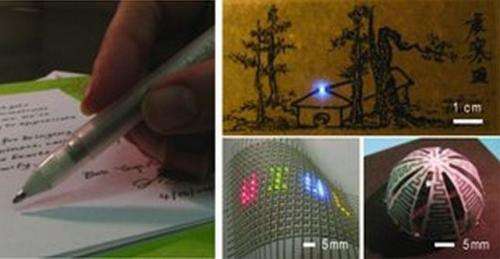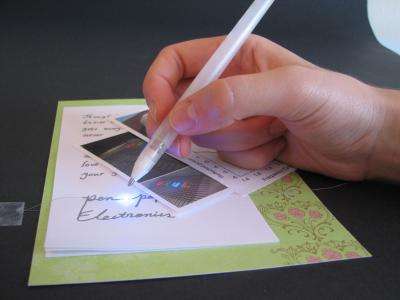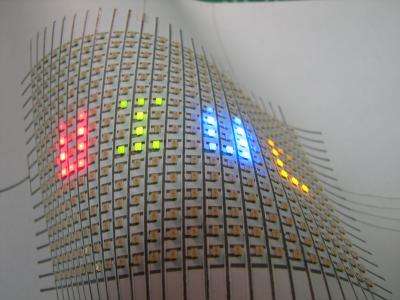June 28, 2011 report
Researchers create rollerball-pen ink to draw circuits

(PhysOrg.com) -- Two professors from the University of Illinois; one specializing in materials science, the other in electrical engineering, have combined their talents to take the idea of printing circuits onto non-standard materials one step further by developing a conductive ink that can be used in a traditional rollerball ink pen to draw circuits by hand onto paper and other porous materials. In their paper published in Advanced Materials, team leads Jennifer Lewis, Jennifer Bernhard and colleagues describe how they were able to make a type of ink from silver nanoparticles that would remain a liquid while in the pen, but would dry like regular ink once applied. The pen could was then used to draw a functioning LCD display and an antenna.
To make the ink, the team produced silver nanoparticles by reducing a silver nitrate solution along with an acid to prevent the particles from growing too large. Afterwards the acid was removed and the viscosity of the ink modified using hydroxyethyl cellulose to get just the right consistency. The result is a sort of liquid metal that dries on contact and which can be used to conduct electricity, hence its ability to be used in the creation of a circuit.

Up till now, most research on printing circuits onto non-standard materials, such as paper, have been done using inkjet printers or even airbrushes. This new approach would allow circuits to be drawn quicker and much cheaper, or even on-the-fly, as no other hardware is needed. Such a low cost device might create a market for throwaway circuits or even super cheap batteries. Paper was used in the study because it is considered to be the most suitable non-standard material for printing circuits due to its wide availability, low cost, ability to be bent and shaped, and the fact that it is biodegradable.
Lewis noted that the paper used in study was folded after testing to see how the circuit would hold up, and discovered it took folding several thousand times before the ink pathways were broken. She also noted that other materials besides paper could be used, such as wood or ceramics.

The team next plans to look into other types of materials that might be used to make conductive ink for their pen, hoping to open up the door to all kinds of inks that can be used for a wide variety of purposes.
More information: Pen-on-Paper Flexible Electronics, Advanced Materials, Article first published online: 20 JUN 2011. DOI:10.1002/adma.201101328
Abstract
Pen-on-paper flexible electronics are fabricated using a conductive silver ink-filled rollerball pen. This approach provides a low-cost, portable route for fabricating conductive text, electronic art, interconnects for light emitting diode (LED) arrays, and three-dimensional (3D) antennas on paper.
© 2010 PhysOrg.com



















